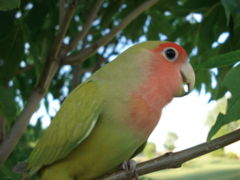Rosy-faced Lovebird
Conservation status Least concern |

|
|
Scientific classification |
| Kingdom: |
Animalia
|
| Phylum: |
Chordata
|
| Class: |
Aves
|
| Order: |
Psittaciformes
|
| Family: |
Psittacidae
|
| Genus: |
Agapornis
|
| Species: |
A. roseicollis
|
|
|
Binomial name |
Agapornis roseicollis
(Vieillot,
1818) |
The Rosy-faced Lovebird (Agapornis roseicollis),
also known as the Peach-faced Lovebird, is a species
of
lovebird native to arid regions in southwestern Africa
such as the Namib Desert. A loud and constant chirper, these birds
are very social animals and often congregate in small groups
in the wild. They eat throughout the day and take frequent
baths. Coloration can vary widely among populations but
females are generally darker and greener, whilst males are
smaller and brighter. Lovebirds are reknowned for their
sleep position in which they sit side-by-side and turn their
faces in towards each other. Also, females are well noted to
tear raw materials into long strips, "twisty-tie" them onto
their backs, and fly distances back to make a nest.
Peach-faced Lovebirds as Pets
Adorable
Housing
Lovebirds, being an active bunch, need some room to move
in their cage. A cage approximately 24" W x 14" D x 30" H is
a good size, but if you can afford it, the bigger the
better. Make sure the bars are spaced no wider than 3/8"
apart, otherwise your bird will be able to stick its head
through the bars. Add a variety of perches, so your lovebird
can excerise its feet to prevent arthritis. The perches
should be at least 4" long and 1/2" in diameter. Also, a
variety of different toys should be placed in the cage to
prevent your bird from boredom and loneliness. Do not get
your lovebird parakeet toys, because they can tear them
apart easily. Try getting cockatiel toys that are more
durable. Do not get toys with small bells, because your
lovebird can get them stuck in its throat. Also, please,
PLEASE don't put the food and water dishes under the
perches, because droppings will contaminate them.
Feeding
Peachfaced lovebirds thrive when fed the proper diet.
They should be fed a wide variety of active food, including
vegetables, whole grains, and fruits. They are not to be fed
dairy products, like chocolate and cheese. Carrots, beans,
squash, and corn are excellent foods that provide healthy
proteins. Grains should include millet, quinoa, winterwheat,
and others. Except strawberries (which contain trace amounts
of carcinogenic pesticides) feed lovebirds a rare treat of
fresh fruit. Many are attuned to the taste of grapes. These
birds also eat various seeds, pellets, and pastas. While
seeds and pellets are easy to give to birds, they are not
part of their natural diet and should be used in conjunction
with vegetables. Good seed and pellet mixes include a large
array of different seed types. Be sure to change any
perishable food within a few hours of placing it in their
housing or at the maximum within one day.
References
- BirdLife International (2004).
Agapornis roseicollis. 2006 IUCN Red List of
Threatened Species. IUCN 2006. Retrieved on 11 May 2006. Database entry
includes justification for why this species is of least
concern
External links




